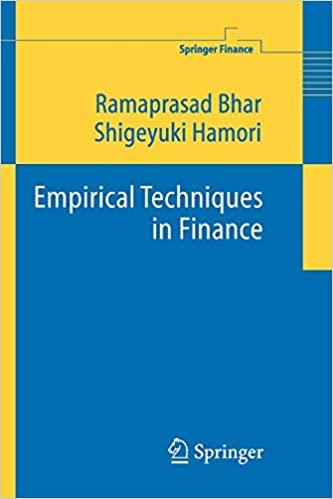Question
This is an individual project Purpose of this project: This project lets you apply what you learn in the FIN 3100 class into a real-world
This is an individual project
Purpose of this project: This project lets you apply what you learn in the FIN 3100 class into a real-world problem. For Finance, Business, and Accounting majors, you should be able to acquire finance basics to handle financial issues.
In the first part, you will evaluate a company by reading its annual report. You must apply Using your knowledge of financial markets, financial statements, and financial statement analysis skills to select one of the most potential U.S. This required a great understanding of chapters 1, 2, 3, 4.
In the second part, you will assess your selected companys bonds and stocks based on your proficiency of time value money, bonds, risk and rate of return, and stocks. To be able to do that, you need to master the content of chapters 5, 7, 8, 9.
Part 2:
After a massive success with your first wealthy client, you got promoted to manager. Congratulation! Now you want to archive even higher targets. You decided to build a financial model that can evaluate any company stock price using Discount Dividend Model and CAPM, that could help you reach the dream of every investor - buy low sell high. Deep down your heart, you know it is not easy, but you will do your best to get what you want.
(*** You can use the same company in Project part 1 or a different company. Usually, young and new companies dont pay dividends, so choose wisely!)
Therefore, the haft of the job has been done by someone else who figured out this formula. Your job now is finding all of the variables. Thats a piece of cake for a financial manager like you!
First, you need to gather the company dividends for the last five years that could be found in their 10-k (usually in item 6. Selected Financial Data).
Like this
Assume that the company keeps the same amount of dividends for the next five years, and after year 5, the growth rate will be a constant of 5% per year. (E.g. the last 5 years dividend is $3, $2.72, $2.4, $2.18, $1.89, the next 5 years will be the same $3, $2.72, $2.4, $2.18, $1.89 and after that growth rate should be constant 5% per year, $1.9845, $2.0837, etc. Hooray, you have the first variable down D0, D1, D2, D3, D4. The second variable, g is given 5%. Only one variable left is rs
The last variable will be rs, discount rate (or in this class, we named it required rate of return). Most of your peers use this information as given information. However, you are a great financial manager, and you learn so hard during FIN 3100 class, so you are crystal clear how to figure out the required rate of return using the Weighted Average Cost of Capital (WACC).
Wow, that is a new challenge that you must come over. After taking a deep breath, you know that:
D: total debt of this company (in the balance sheet)
E: total equity of this company (in the balance sheet)
Kd: cost of debt (interest rates should be found somewhere in the 10-k or you can use 2% for your convenience)
MTR: Marginal Tax Rate (should be found somewhere in the 10-k or you can use 40% for your convenience)
Ke: Cost of equity (This is needed to calculate using CAPM: ke =Rf + (Exp Ret Mkt-Rf)). However, your boss gives you a hand and research it for you. The ke of this company is 5%.
You must write a two-page report to show your boss how talented and ambitious you are for the next promotion opportunities. This report includes the most professional step by step, how you build up this model, and your judgment about the stock price.
Step by Step Solution
There are 3 Steps involved in it
Step: 1

Get Instant Access to Expert-Tailored Solutions
See step-by-step solutions with expert insights and AI powered tools for academic success
Step: 2

Step: 3

Ace Your Homework with AI
Get the answers you need in no time with our AI-driven, step-by-step assistance
Get Started


